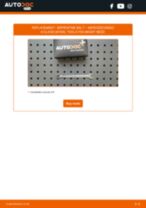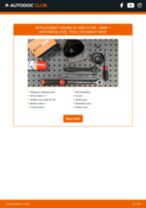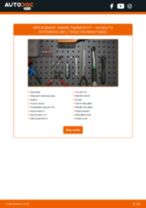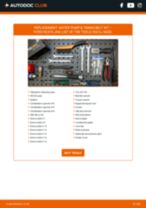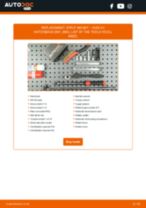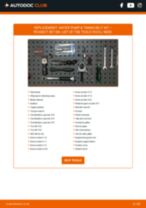What does code P0420 mean?
The engine control unit (ECU) triggers this DTC when it detects that the catalytic converter is not working efficiently. The neutralisation component is monitored by two sensors. If the upstream and downstream sensors are showing the similar readings, it could indicate that the oxygen levels are too high.
What are the causes of this fault?
- Damage or leaks in the exhaust manifold
- Engine misfires
- A leaky fuel injector
- Oxygen and coolant temperature sensor malfunctions
- Excessive fuel pressure
- Oil in the catalytic converter
- Broken wires and faulty electrical connectors
- Open or short circuits
- Exhaust pipe damage or leaks
- A defective muffler
Symptoms of code P0420
Here are the most common symptoms of the mechanical and electrical problems related to this DTC:
- A “rotten egg” smell coming from the exhaust system. High oxygen levels may lead to an increase in sulphur in the fuel system, producing a foul odour
- The check engine light comes on. This could occur due to a number of reasons. It is important to get a proper diagnosis in order to rectify the issue.
- Slow acceleration and a loss of engine power. You may notice that the vehicle is unable to reach higher speeds than 30-40 mph.
- Higher fuel consumption
- Rough idling
- Starting difficulties
Recommended repairs
It highly recommended that you conduct a series of diagnostic checks to determine and address the root of the problem. Catalytic converters are very expensive to replace, but the unit can often be restored by simply replacing devices, cables and pipes or decontaminating the unit.
- The first thing you should do is diagnose the fault. You can do this by scanning the system using an OBD2 scan tool and checking the error codes. There is plenty of information available on these errors online.
- Check whether there is a problem with the oxygen sensors themselves. Inspect the components for signs of damage or wear. You should check the voltage in the devices using a voltmeter and compare the readings to the standard values.
- Check the cables and connectors for damage and replace them if necessary. If the monitoring devices are still malfunctioning after new parts are installed, you may need to replace them. It may also be possible to restore the power supply by cleaning the connectors with a specialised cleaning agent for improved conductivity. It will also help to prevent issues such as corrosion in the future.
- Repair or replace fuel injectors when leaks are detected.
- Inspect the exhaust manifold, muffler, and exhaust pipe for leaks and other defects. Repairing minor leaks often involves replacing old seals, broken pipes and hoses, and fasteners. Sometimes repairs require professional welding.
- Diagnose the cause of engine misfires and repair the system.
Frequently Asked Questions (FAQ)
How can I get rid of the P0420 code?
You can clear it temporarily by either disconnecting the negative battery terminal or using an OBD2 scanner. Once you have done this, it is advisable to take the vehicle for a short test drive to see if it reappears. This way, you can make sure that it wasn’t a false error.
If it is triggered by the ECU again, you will need to find the cause and fix it before resetting the computer for a second time.
Can I still drive my car if this error appears?
Yes, it doesn’t usually pose an immediate threat to the driver and passengers. However, it will affect the performance and power of the vehicle. It is advisable to have the vehicle repaired as soon as possible to prevent further damage and breakdowns. The sooner it is fixed, the easier it will be to avoid more expensive repairs.
How much does it cost to fix the P0420 fault?
It really depends on the severity and nature of the problem. The exact cost cannot be calculated until you receive a full diagnosis for the vehicle. In the UK, the average price for a catalytic converter replacement ranges between £150-£1000 depending on the model.
 How to change front wheel bearing on MERCEDES-BENZ M W163 TUTORIAL | AUTODOC
How to change front wheel bearing on MERCEDES-BENZ M W163 TUTORIAL | AUTODOC How to change fuel filter BMW 3 (E90) [TUTORIAL AUTODOC]
How to change fuel filter BMW 3 (E90) [TUTORIAL AUTODOC] How to change Front wheel bearing on VW GOLF 4 TUTORIAL | AUTODOC
How to change Front wheel bearing on VW GOLF 4 TUTORIAL | AUTODOC How to change a rear brake pads FORD FOCUS 3 TUTORIAL | AUTODOC
How to change a rear brake pads FORD FOCUS 3 TUTORIAL | AUTODOC How to change pollen filter / cabin filter on AUDI A6 (C6) [TUTORIAL AUTODOC]
How to change pollen filter / cabin filter on AUDI A6 (C6) [TUTORIAL AUTODOC] How to change engine thermostat on PEUGEOT 207 [TUTORIAL AUTODOC]
How to change engine thermostat on PEUGEOT 207 [TUTORIAL AUTODOC] How to change fuel filter NISSAN X-TRAIL T30 TUTORIAL | AUTODOC
How to change fuel filter NISSAN X-TRAIL T30 TUTORIAL | AUTODOC How to change front wheel bearing TOYOTA YARIS XP10 TUTORIAL | AUTODOC
How to change front wheel bearing TOYOTA YARIS XP10 TUTORIAL | AUTODOC Ask on the forum
Ask on the forum
 How to Get the Best Deals on Car Parts | Save Money with AUTODOC
How to Get the Best Deals on Car Parts | Save Money with AUTODOC How to remove scratches from car plastic | AUTODOC tips
How to remove scratches from car plastic | AUTODOC tips How I started restoring a driveshaft | Drivetrain restoration – Part 1
How I started restoring a driveshaft | Drivetrain restoration – Part 1 Top 5 mistakes when replacing spark plugs | AUTODOC tips
Top 5 mistakes when replacing spark plugs | AUTODOC tips


